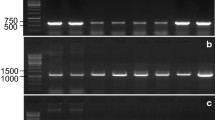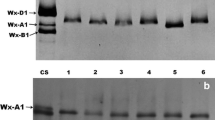Abstract
Waxy gene plays a key role for amylose synthesis in wheat seeds. The study evaluated the Waxy gene variability in 59 accessions of six diploid Triticum and Aegilops species. The percentages of variable sites, singleton variable sites, and parsimony informative sites were 16.38, 5.59, and 10.79 %, respectively. A total of 22 amino acid changes in the transit peptide and the remaining in the mature protein were observed. Moreover, 17 amino acid changes between Triticum and Aegilops species were also detected. Specially, Gla 14 and Phe 153 was observed in diploid Triticum, compared with Thr 14 and Tyr 153 in diploid Aegilops. Two types of amino acids, Gla 5/Val 5 and Ile 140/Val 140, were identified in T. urartu, as well as Val 22/Phe 22, Thr 52/Lys 52, and Gln 54/delete in A. tauschii. The insertion/deletions (InDels) had high frequency in intron region, but very low in transit peptide and exon region. Neighbour-joining tree showed that 146 sequences from 23 species could be clustered into eight groups with the species characterizations. The Wx-B1 of polyploid Triticum were grouped with A. sharonensis, A. longissima, A. searsii, A. speltoides, while Wx-D1 of T. aestivum and T. spelta together with A. umbellulata, A. markgrafii, A. comosa, and A. tauschii. The Wx-A1 of polyploid Triticum were separated clearly with the diploid species. The Wx-B1 could be divided into two subgroups and maybe had two phylogenetic origins, but most of them were related to A. speltoides. Waxy gene of A. tauschii also had two subgroups, and the sequences from southern Caspian (Mazandaran, Iran) were more closed with Wx-D1. The variability of 5′ Un-Translation Region (UTR) of waxy was stronger than intron and exon region based on genetic distance. Phylogeography analysis showed that geography affected strongly the distribution of all accessions along the north–south axis based on the partial open reading fragment (ORF) of waxy gene, A. speltoides and A. longissima along the west–east axis and north–south axis based on exon, and A. tauschii along the west–east axis based on 5′ UTR, respectively. Our results suggest that diploid Triticum and Aegilops have new waxy gene resources; waxy gene could play a more important role in genetic exploitation, genetic relationship evaluation and phylogeography investigation.




Similar content being viewed by others
References
Ainsworth C, Clark J, Balsdon J (1993) Expression, organisation and structure of the genes encoding the waxy protein (granule-bound starch synthase) in wheat. Plant Mol Biol 22:67–82
Avise JC (1998) The history and purview of phylogeography: a personal reflection. Mol Ecol 7:371–379
Baumel A, Ainouche ML, Bayer RJ, Ainouche AK, Misset MT (2002) Molecular phylogeny of hybridizing species from the genus Spartina Schreb. (Poaceae). Mol Phylogenet Evol 22(2):303–314
Domon E, Saito A, Takeda K (2002) Comparison of the waxy locus sequence from a non-waxy strain and two waxy mutants of spontaneous and artificial origins in barley. Genes Genet Syst 77(5):351–359
Dvorak J, Pantaleo DT, Zhang HB, Resta P (1993) The evolution of polyploid wheats: identification of the A genome donor species. Genome 36:21–31
Dvorak J, Luo MC, Yang ZL, Zhang HB (1998) The structure of the Aegilops tauschii genepool and the evolution of hexaploid wheat. Theor Appl Genet 97:657–670
Dvorak J, Deal KR, Luo MC, You FM, von Borstel K, Dehghani H (2012) The origin of spelt and free-threshing hexaploid wheat. J Hered 103:426–441
Evans RC, Alice LA, Campbell CS, Kellogg EA, Dickinson TA (2000) The granule-bound starch synthase (GBSS) gene in the Rosaceae: multiple loci and phylogenetic utility. Mol Phylogenet Evol 17:388–400
Fortune PM, Schierenbeck KA, Ainouche AK, Jacquemin J, Wendel JF, Ainouche ML (2007) Evolutionary dynamics of waxy and the origin of hexaploid Spartina species (Poaceae). Mol Phylogenet Evol 43:1040–1055
Guzmán C, Alvarez JB (2012) Molecular characterization of a novel waxy allele (Wx-A u 1a) from Triticum urartu Thum. ex Gandil. Genet Resour Crop Evol 59(6):971–979
Guzmán C, Caballero L, Alvarez JB (2009) Variation in Spanish cultivated einkorn wheat (Triticum monococcum L. ssp. monococcum) as determined by morphological traits and waxy proteins. Genet Resour Crop Evol 56:601–604
Guzmán C, Caballero L, Alvarez JB (2011) Molecular characterization of the Wx-B1 allelic variants identified in cultivated emmer wheat and comparison with those of durum wheat. Mol Breed 28:403–411
Guzmán C, Caballero L, Martín LM, Alvarez JB (2012a) Waxy genes from spelt wheat: new alleles for modern wheat breeding and new phylogenetic inferences about the origin of this species. Ann Bot 110:1161–1171
Guzmán C, Caballero L, Yamamori M, Alvarez JB (2012b) Molecular characterization of a new waxy allele with partial expression in spelt wheat. Planta 235:1331–1339
Hall TA (1999) BioEdit: a user-friendly biological sequence alignment editor and analysis program for Windows 95/98/NT. Nucleic Acids Symp Ser 41:95–98
Hammer K, Filatenko AA, Pistrick K (2011) Taxonomic remarks on Triticum L. and ×Triticosecale Wittm. Genet Resour Crop Evol 58:3–10
Huang XQ, Brûlé-Babel A (2010) Development of genome-specific primers for homoeologous genes in allopolyploid species: the waxy and starch synthase II genes in allohexaploid wheat (Triticum aestivum L.) as examples. BMC Res Notes 3:140
Jaaska V (1980) Electrophoretic survey of seedling esterases in wheats in relation to their phylogeny. Theor Appl Genet 56:273–284
Kidd DM, Liao X (2006) Phylogeographic information systems: putting the geography into phylogeography. J Biogeogr 33:1851–1865
Kluth A, Sprunck S, Becker D, Lörz H, Lütticke S (2002) 5′ deletion of a gbssI promoter region from wheat leads to changes in tissue and developmental specificities. Plant Mol Biol 49:669–682
Lagudah ES, Appels R, Brown ADH (1991) The molecular-genetic analysis of Triticum tauschii, the D genome donor to hexaploid wheat. Genome 36:913–918
Larkin MA, Blackshields G, Brown NP, Chenna R, McGettigan PA, McWilliam H, Valentin F, Wallace IM, Wilm A, Lopez R, Thompson JD, Gibson TJ, Higgins DG (2007) Clustal W and Clustal X version 2.0. Bioinformatics 23:2947–2948
Li W, Gao Z, Xiao W, Wei YM, Liu YX, Chen GY, Pu ZE, Chen HP, Zheng YL (2012) Molecular diversity of restriction enzyme sites, indels and upstream open reading frame (uORFs ) of 5′ untransalted regions (UTRs) of Waxy genes in Triticum L. and Aegilops L. species. Genet Resour Crop Evol 59:1625–1647
Li W, Wei YM, Xu LL, Liu AJ, Sheng YZ, Pu ZE, Cheng GY, Zheng YL (2014) Evaluation of geographic distribution of high-molecular-weight glutenin subunits (HMW-GS) in wild and cultivated Triticum species. Genet Resour Crop Evol 61:1105–1119
Ma J, Jiang QT, Zhao QZ, Zhao S, Lan XJ, Dai SF, Lu ZX, Liu C, Wei YM, Zheng YL (2013) Characterization and expression analysis of waxy alleles in barley accessions. Genetica 141(4–6):227–238
Martin C, Smith AM (1995) Starch biosynthesis. Plant Cell 7:971–985
Mason-Gamer RJ, Weil CF, Kellogg EA (1998) Granule-bound starch synthase: structure, function, and phylogenetic utility. Mol Biol Evol 15:1658–1673
Mizuno N, Yamasaki M, Matsuoka Y, Kawahara T, Takumi S (2010) Population structure of wild wheat D-genome progenitor Aegilops tauschii Coss.: implications for intraspecific lineage diversification and evolution of common wheat. Mol Ecol 19:999–1013
Monari AM, Simeone MC, Urbano M, Margiotta B, Lafiandra D (2005) Molecular characterization of new waxy mutants identified in bread and durum wheat. Theor Appl Genet 110:1481–1489
Moore MJ, Jansen RK (2006) Molecular evidence for the age, origin, and evolutionary history of the American desert plant genus Tiquilia (Boraginaceae). Mol Phylogenet Evol 39:668–687
Murai J, Taira T, Ohta D (1999) Isolation and characterization of the three Waxy genes encoding the granule-bound starch synthase in hexaploid wheat. Gene 234:71–79
Nakai Y (1979) Isozyme variation in Aegilops and Triticum, IV. The origin of the common wheats revealed from the study on esterase isozymes in synthesized hexaploid wheats. Jpn J Genet 54:175–189
Olsen KM, Purugganan MD (2002) Molecular evidence on the origin and evolution of glutinous rice. Genetics 162:941–950
Ortega R, Guzmán C, Alvarez JB (2014a) Wx gene in diploid wheat: molecular characterization of five novel alleles from einkorn (Triticum monococcum L. ssp. monococcum) and T. urartu. Mol Breed 34:1137–1146
Ortega R, Alvarez JB, Guzmán C (2014b) Characterization of the Wx gene in diploid Aegilops species and its potential use in wheat breeding. Genet Resour Crop Evol 61:369–382
Parks DH, Beiko RG (2009) Quantitative visualizations of hierarchically organized data in a geographic context. Geoinformatics. 17th International conference on, August 12–14, pp 1–6
Parks DH, Porter M, Churcher S, Wang S, Blouin C, Whalley J, Brooks S, Beiko RG (2009) GenGIS: a geospatial information system for genomic data. Genome Res 19:1896–1904
Peralta IE, Spooner DM (2001) Granule-bound starch synthase (GBSSI) gene phylogeny of wild tomatoes (Solanum L. section Lycopersicon [Mill.] Wettst. subsection Lycopersicon). Am J Bot 88(10):1888–1902
Rodriguez-Quijano M, Lucas R, Carrillo JM (2003) Waxy proteins and amylose content in tetraploid wheats Triticum dicoccum Schuld., Triticum durum L. and Triticum polonicum L. Euphytica 134:97–101
Rohde W, Becker D, Salamini F (1988) Structural analysis of the waxy locus from Hordeum vulgare. Nucl Acids Res 16(14B):7185–7186
Saitou N, Nei M (1987) The neighbor-joining method: a new method for reconstructing phylogenetic trees. Mol Biol Evol 4:406–425
Sestili F, Botticella E, Bedo Z, Phillips A, Lafiandra D (2010) Production of novel allelic variation for genes involved in starch biosynthesis through mutagenesis. Mol Breed 25:145–154
Shapter FM, Eggler P, Lee LS, Henry RJ (2009) Variation in granule bound starch synthase I (GBSSI) loci amongst Australian wild cereal relatives (Poaceae). J Cereal Sci 49(1):4–11
Smith AM, Denyer K, Martin C (1997) The synthesis of starch granule. Annu Rev Plant Physiol Plant Mol Biol 48:67–87
Tamura K, Dudley J, Nei M, Kumar S (2007) MEGA4: Molecular Evolutionary Genetics Analysis (MEGA) software version 4.0. Mol Biol Evol 24:1596–1599
Urbano M, Margiotta B, Colaprico G, Lafiandra D (2002) Waxy proteins in diploid, tetraploid and hexaploid wheat. Plant Breed 121:465–469
Van Slageren MW (1994) Wild wheats: a monograph of Aegilops L. and Amblyopyrum (Jaub. & Spach) Eig (Poaceae). Agricultural University Papers, Wageningen
Wang JR, Wei YM, Long XY, Yan ZH, Nevo E, Baum BR, Zheng YL (2008) Molecular evolution of dimeric a-amylase inhibitor genes in wild emmer wheat and its ecological association. BMC Evol Biol 8:91
Wang JR, Luo MC, Chen ZX, You FM, Wei YM, Zheng YL, Dvorak J (2013) Aegilops tauschii single nucleotide polymorphisms shed light on the origins of wheat D-genome genetic diversity and pinpoint the geographic origin of hexaploid wheat. New Phytol 198:925–937
Whitt SR, Wilson LM, Tenaillon MI, Gaut BS, Buckler ES (2002) Genetic diversity and selection in the maize starch pathway. Proc Natl Acad Sci USA 99(20):12959–12962
Xu J, Frick M, Laroche A, Ni ZF, Li BY, Lu ZX (2009a) Isolation and characterization of the rye Waxy gene. Genome 52(7):658–664
Xu LL, Li W, Wei YM, Zheng YL (2009b) Genetic diversity of HMW glutenin subunits in diploid, tetraploid and hexaploid Triticum species. Genet Resour Crop Evol 56:377–391
Yamamori M, Guzmán C (2013) SNPs and an insertion sequence in five Wx-A1 alleles as factors for variant Wx-A1 protein in wheat. Euphytica 192:325–338
Yan LL, Bhave M, Fairclough R, Konik C, Rahman S, Appels R (2000) The genes encoding granule-bound starch synthases at the waxy loci of the A, B, and D progenitors of common wheat. Genome 43:264–272
Zhang LY, Ravel C, Bernard M, Balfourier F, Leroy P, Feuillet C, Sourdille P (2006) Transferable bread wheat EST–SSRs can be useful for phylogenetic studies among the Triticeae species. Theor Appl Genet 113:407–441
Zimmer EA, Wen J (2012) Using nuclear gene data for plant phylogenetics: progress and prospects. Mol Phylogenet Evol 65:774–785
Acknowledgments
This work was supported by The Key Project of National Natural Science Foundation of China (No. 31230053) and The International Science & Technology Cooperation Program of China (No. 2015DFA30600).
Author information
Authors and Affiliations
Corresponding authors
Rights and permissions
About this article
Cite this article
Li, W., Fu, BB., Li, Z. et al. Characterization of the waxy gene in diploid Triticum L. and Aegilops L. species and its geographic distribution. Genet Resour Crop Evol 63, 987–1002 (2016). https://doi.org/10.1007/s10722-015-0296-5
Received:
Accepted:
Published:
Issue Date:
DOI: https://doi.org/10.1007/s10722-015-0296-5




